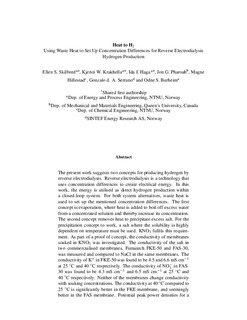Heat to H2: Using Waste Heat to Set Up Concentration Differences for Reverse Electrodialysis Hydrogen Production
Skilbred, Ellen Synnøve; Krakhella, Kjersti Wergeland; Haga, Ida Johanne; Pharoah, Jon; Hillestad, Magne; del Alamo Serrano, Gonzalo; Burheim, Odne Stokke
Journal article, Peer reviewed
Accepted version
Permanent lenke
http://hdl.handle.net/11250/2584837Utgivelsesdato
2018Metadata
Vis full innførselSamlinger
Sammendrag
The present work suggests two concepts for producing hydrogen by reverse electrodialysis. Reverse electrodialysis is a technology that uses concentration differences to create electrical energy. In this work, the energy is utilised as direct hydrogen production within a closed-loop system. For both system alternatives, waste heat is used to set up the mentioned concentration differences. The first concept is evaporation, where heat is added to boil off excess water from a concentrated solution and thereby increase its concentration. The second concept removes heat in order to precipitate excess salt. For the precipitation concept to work, a salt where the solubility is highly dependent on temperature must be used. KNO3 fulfils this requirement. As part of a proof of concept, the conductivity of membranes soaked in KNO3 was investigated. The conductivity of the salt in two commercialised membranes, Fumatech FKE-50 and FAS-30, was measured and compared to NaCl in the same membranes. The conductivity of K+ in FKE-50 was found to be 4.5 and 6.6 mS cm−1 at 25◦C and 40◦C respectively. The conductivity of NO−3 in FAS-30 was found to be 4.3 mS cm−1 and 6.5 mS cm−1 at 25◦C and 40◦C respectively. Neither of the membranes change conductivity with soaking concentrations. The conductivity at 40◦C compared to 25◦C is significantly better in the FKE membrane, and seemingly better in the FAS membrane. Potential peak power densities for a RED unit cell is 1.29 W m−2 with the precipitation system, and 28.1 W m−2 when evaporation is used.
